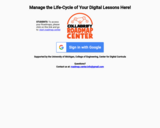
Learn about the moon and the moon phases, where is it from and where is it going with fun activities, simulates, songs and crafts.
- Subject:
- Astronomy
- Physical Science
- Material Type:
- Activity/Lab
- Interactive
- Author:
- UMCDC
- Date Added:
- 06/07/2023

Learn about the moon and the moon phases, where is it from and where is it going with fun activities, simulates, songs and crafts.
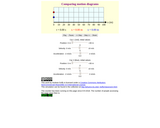
?What is Motion Diagrams in one dimension هذه المحاكاة تتحدث عن الحركة في بعد واحد

This simulation is about Motion with Constant Acceleration
هذه المحاكاة تشرح عن الحركة مع التسارع المستمر

In this activity about electricity and magnetism, learners examine what happens when a magnet exerts a force on a current-carrying wire. Using a simple device, learners discover that when an electrical current flows through a magnetic field, a force is exerted on the current and this force can be used to make an electric motor. Learners will experiment to find out what happens when they reverse the direction of current flow. They will also discover a mathematical tool called the "right-hand rule."
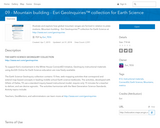
This activity illustrates how global mountain ranges are formed related to plate motions.
GeoInquiries are designed to be fast and easy-to-use instructional resources that incorporate advanced web mapping technology. Each 15-minute activity in a collection is intended to be presented by the instructor from a single computer/projector classroom arrangement. No installation, fees, or logins are necessary to use these materials and software.

An interactive activity that begins with a PowerPoint and ends with groups of students working on creating their own mountain effects out of materials. Warning: Need to prepare in advance for the activity. (Materials used for fold mountains are paper; tissue paper and thicker more scratchy type material to reflect differences in the earth's surface).

Learn about position, velocity, and acceleration graphs. Move the little man back and forth with the mouse and plot his motion. Set the position, velocity, or acceleration and let the simulation move the man for you.

Build your own system of heavenly bodies and watch the gravitational ballet. With this orbit simulator, you can set initial positions, velocities, and masses of 2, 3, or 4 bodies, and then see them orbit each other.
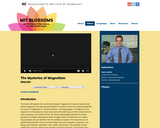
This lesson will explore the connections between magnetism in natural materials and electromagnetism. The ultimate goal will be for students to form an understanding that the source of magnetism in natural materials is moving charges. It is helpful, but not required, for the students to have some work with electricity, and other distance forces (such as gravity or the electric force). The lesson will probably take two 50-minute periods to complete. Although the video footage is brief, the activities are in depth, inquiry-based, and can take time for the students to explore. The materials are not specifically prescribed, but can include things such as bar magnets, compasses, iron filings, wire, batteries, steel bolts, coils, straws, and hot glue. The activities include drawing the magnetic fields of bar magnets and electromagnets. The activities also include making a magnet from a drinking straw and iron filings.

This lesson will explore the connections between magnetism in natural materials and electromagnetism. The ultimate goal will be for students to form an understanding that the source of magnetism in natural materials is moving charges. It is helpful, but not required, for the students to have some work with electricity, and other distance forces (such as gravity or the electric force). The lesson will probably take two 50-minute periods to complete. Although the video footage is brief, the activities are in depth, inquiry-based, and can take time for the students to explore. The materials are not specifically prescribed, but can include things such as bar magnets, compasses, iron filings, wire, batteries, steel bolts, coils, straws, and hot glue. The activities include drawing the magnetic fields of bar magnets and electromagnets. The activities also include making a magnet from a drinking straw and iron filings.
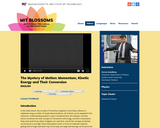
In this video lesson, the concept of momentum applied to hard-body collisions is explained using a number of simple demonstrations, all of which can be repeated in the classroom. Understanding Newton's Laws is fundamental to all of physics, and this lesson introduces the vital concepts of momentum and energy, and their conservation. Only some preliminary ideas of algebra are used here, and all the concepts presented can be found in any high-school level physics book. In terms of materials required, getting hold of large steel balls may not be easy, but large ball bearings can be procured easily. On the basis of what students have learned in the video, teachers can easily generate a large number of questions that relate to one's daily experiences, or which pose new challenges: for example, in a collision between a heavy and light vehicle, why do those inside the lighter one suffer less injury?

In this video lesson, the concept of momentum applied to hard-body collisions is explained using a number of simple demonstrations, all of which can be repeated in the classroom. Understanding Newton's Laws is fundamental to all of physics, and this lesson introduces the vital concepts of momentum and energy, and their conservation. Only some preliminary ideas of algebra are used here, and all the concepts presented can be found in any high-school level physics book. In terms of materials required, getting hold of large steel balls may not be easy, but large ball bearings can be procured easily. On the basis of what students have learned in the video, teachers can easily generate a large number of questions that relate to one's daily experiences, or which pose new challenges: for example, in a collision between a heavy and light vehicle, why do those inside the lighter one suffer less injury?
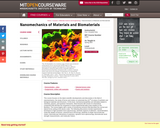
This course focuses on the latest scientific developments and discoveries in the field of nanomechanics, the study of forces and motion on extremely tiny (10-9 m) areas of synthetic and biological materials and structures. At this level, mechanical properties are intimately related to chemistry, physics, and quantum mechanics. Most lectures will consist of a theoretical component that will then be compared to recent experimental data (case studies) in the literature. The course begins with a series of introductory lectures that describes the normal and lateral forces acting at the atomic scale. The following discussions include experimental techniques in high resolution force spectroscopy, atomistic aspects of adhesion, nanoindentation, molecular details of fracture, chemical force microscopy, elasticity of single macromolecular chains, intermolecular interactions in polymers, dynamic force spectroscopy, biomolecular bond strength measurements, and molecular motors.

Lesson looking at different uses of nanotechnology. Lesson activity depicted on the PowerPoint. The sunscreen article is higher level; providing differentiation. Nanoscale and web link help students understand the relative size of nanotechnology.
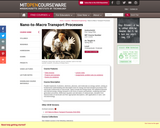
Parallel treatments of photons, electrons, phonons, and molecules as energy carriers, aiming at fundamental understanding and descriptive tools for energy and heat transport processes from nanoscale continuously to macroscale. Topics include the energy levels, the statistical behavior and internal energy, energy transport in the forms of waves and particles, scattering and heat generation processes, Boltzmann equation and derivation of classical laws, deviation from classical laws at nanoscale and their appropriate descriptions, with applications in nano- and microtechnology.

Students learn about frequency and period, particularly natural frequency using springs. They learn that the natural frequency of a system depends on two things: the stiffness and mass of the system. Students see how the natural frequency of a structure plays a big role in the building surviving an earthquake or high winds.
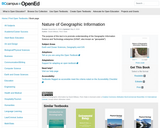
The purpose of this text is to promote understanding of the Geographic Information Science and Technology enterprise (GIS&T, also known as “geospatial”).
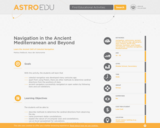
This lesson unit provides an insight into the navigational methods of the Bronze Age Mediterranean peoples. The students explore the link between history and astronomical knowledge. Besides an overview of ancient seafaring in the Mediterranean, the students use activities to explore early navigational skills using the stars and constellations and their apparent nightly movement across the sky. In the course of the activities, they become familiar with the stellar constellations and how they are distributed across the northern and southern sky.
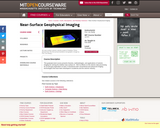
This graduate level course presents theories, methodologies, and applications of seismic imaging for solving the shallow near-surface (0 - 500 m) effects on the seismic data processing for oil and gas exploration on land. It introduces both conventional and advanced imaging technologies that have been developed in academia and the seismic industry.

Produce light by bombarding atoms with electrons. See how the characteristic spectra of different elements are produced, and configure your own element's energy states to produce light of different colors.